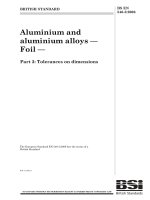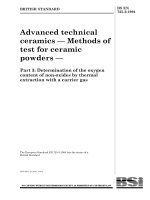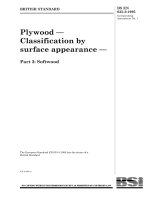Bsi bs en 62215 3 2013
Bạn đang xem bản rút gọn của tài liệu. Xem và tải ngay bản đầy đủ của tài liệu tại đây (1.27 MB, 36 trang )
BS EN 62215-3:2013
BSI Standards Publication
Integrated circuits —
Measurement of impulse
immunity
Part 3: Non-synchronous transient
injection method
BRITISH STANDARD
BS EN 62215-3:2013
National foreword
This British Standard is the UK implementation of EN 62215-3:2013. It is
identical to IEC 62215-3:2013.
The UK participation in its preparation was entrusted to Technical
Committee EPL/47, Semiconductors.
A list of organizations represented on this committee can be obtained on
request to its secretary.
This publication does not purport to include all the necessary provisions of
a contract. Users are responsible for its correct application.
© The British Standards Institution 2013.
Published by BSI Standards Limited 2013
ISBN 978 0 580 69165 2
ICS 31.200
Compliance with a British Standard cannot confer immunity from
legal obligations.
This British Standard was published under the authority of the
Standards Policy and Strategy Committee on 31 October 2013.
Amendments/corrigenda issued since publication
Date
Text affected
BS EN 62215-3:2013
EUROPEAN STANDARD
EN 62215-3
NORME EUROPÉENNE
October 2013
EUROPÄISCHE NORM
ICS 31.200
English version
Integrated circuits Measurement of impulse immunity Part 3: Non-synchronous transient injection method
(IEC 62215-3:2013)
Circuits intégrés Mesure de l'immunité aux impulsions Partie 3: Méthode d'injection de
transitoires non synchrones
(CEI 62215-3:2013)
Integrierte Schaltungen Messung der Störfestigkeit
gegen Impulse Teil 3: Asynchrones
Transienteneinspeisungs-Verfahren
(IEC 62215-3:2013)
This European Standard was approved by CENELEC on 2013-08-21. CENELEC members are bound to comply
with the CEN/CENELEC Internal Regulations which stipulate the conditions for giving this European Standard
the status of a national standard without any alteration.
Up-to-date lists and bibliographical references concerning such national standards may be obtained on
application to the CEN-CENELEC Management Centre or to any CENELEC member.
This European Standard exists in three official versions (English, French, German). A version in any other
language made by translation under the responsibility of a CENELEC member into its own language and notified
to the CEN-CENELEC Management Centre has the same status as the official versions.
CENELEC members are the national electrotechnical committees of Austria, Belgium, Bulgaria, Croatia, Cyprus,
the Czech Republic, Denmark, Estonia, Finland, Former Yugoslav Republic of Macedonia, France, Germany,
Greece, Hungary, Iceland, Ireland, Italy, Latvia, Lithuania, Luxembourg, Malta, the Netherlands, Norway, Poland,
Portugal, Romania, Slovakia, Slovenia, Spain, Sweden, Switzerland, Turkey and the United Kingdom.
CENELEC
European Committee for Electrotechnical Standardization
Comité Européen de Normalisation Electrotechnique
Europäisches Komitee für Elektrotechnische Normung
CEN-CENELEC Management Centre: Avenue Marnix 17, B - 1000 Brussels
© 2013 CENELEC -
All rights of exploitation in any form and by any means reserved worldwide for CENELEC members.
Ref. No. EN 62215-3:2013 E
BS EN 62215-3:2013
EN 62215-3:2013
-2-
Foreword
The text of document 47A/881/CDV, future edition 1 of IEC 62215-3, prepared by SC 47A “Integrated
circuits” of IEC/TC 47 “Semiconductor devices” was submitted to the IEC-CENELEC parallel vote and
approved by CENELEC as EN 62215-3:2013.
The following dates are fixed:
•
latest date by which the document has to be
implemented at national level by
publication of an identical national
standard or by endorsement
(dop)
2014-05-21
•
latest date by which the national
standards conflicting with the
document have to be withdrawn
(dow)
2016-08-21
Attention is drawn to the possibility that some of the elements of this document may be the subject of
patent rights. CENELEC [and/or CEN] shall not be held responsible for identifying any or all such
patent rights.
Endorsement notice
The text of the International Standard IEC 62215-3:2013 was approved by CENELEC as a European
Standard without any modification.
BS EN 62215-3:2013
EN 62215-3:2013
-3-
Annex ZA
(normative)
Normative references to international publications
with their corresponding European publications
The following documents, in whole or in part, are normatively referenced in this document and are
indispensable for its application. For dated references, only the edition cited applies. For undated
references, the latest edition of the referenced document (including any amendments) applies.
NOTE When an international publication has been modified by common modifications, indicated by (mod), the relevant EN/HD
applies.
Publication
Year
IEC 60050
Title
EN/HD
Year
Series International Electrotechnical Vocabulary
(IEV)
-
-
IEC 61000-4-4
2012
Electromagnetic compatibility (EMC) Part 4-4: Testing and measurement
techniques - Electrical fast transient/burst
immunity test
EN 61000-4-4
2012
IEC 61000-4-5
+ corr. October
2005
2009
Electromagnetic compatibility (EMC) Part 4-5: Testing and measurement
techniques - Surge immunity test
EN 61000-4-5
2006
IEC 62132-4
2006
Integrated circuits - Measurement of
EN 62132-4
electromagnetic immunity, 150 kHz to 1 GHz
- Part 4: Direct RF power injection method
2006
ISO 7637-2
2011
Road vehicles - Electrical disturbances from conduction and coupling Part 2: Electrical transient conduction along
supply lines only
-
–2–
BS EN 62215-3:2013
62215-3 © IEC:2013
CONTENTS
1
Scope ............................................................................................................................... 6
2
Normative references ....................................................................................................... 6
3
Terms and definitions ....................................................................................................... 6
4
General ............................................................................................................................ 8
5
Coupling networks ............................................................................................................ 9
5.1
5.2
6
General on coupling networks ................................................................................. 9
Supply injection network .......................................................................................... 9
5.2.1 Direct injection ............................................................................................ 9
5.2.2 Capacitive coupling ................................................................................... 10
5.3 Input injection ........................................................................................................ 10
5.4 Output injection ..................................................................................................... 11
5.5 Simultaneous multiple pin injection ........................................................................ 12
IC configuration and evaluation ...................................................................................... 12
7
6.1
6.2
6.3
Test
IC configuration and operating modes ................................................................... 12
IC monitoring ......................................................................................................... 13
IC performance classes ......................................................................................... 13
conditions ............................................................................................................... 14
8
7.1
7.2
7.3
7.4
Test
General ................................................................................................................. 14
Ambient electromagnetic environment ................................................................... 14
Ambient temperature ............................................................................................. 14
IC supply voltage ................................................................................................... 14
equipment ............................................................................................................... 14
9
8.1
8.2
8.3
8.4
8.5
8.6
8.7
Test
General requirements for test equipment ............................................................... 14
Cables ................................................................................................................... 14
Shielding ............................................................................................................... 14
Transient generator ............................................................................................... 14
Power supply ......................................................................................................... 14
Monitoring and stimulation equipment ................................................................... 14
Control unit ........................................................................................................... 15
set up ..................................................................................................................... 15
9.1 General ................................................................................................................. 15
9.2 EMC test board ..................................................................................................... 15
10 Test procedure ............................................................................................................... 17
10.1
10.2
10.3
10.4
10.5
10.6
11 Test
Test plan ............................................................................................................... 17
Test preparation .................................................................................................... 17
Characterization of coupled impulses .................................................................... 17
Impulse immunity measurement ............................................................................ 17
Interpretation and comparison of results ................................................................ 18
Transient immunity acceptance level ..................................................................... 18
report ...................................................................................................................... 18
Annex A (informative) Test board recommendations ............................................................ 19
Annex B (informative) Selection hints for coupling and decoupling network values ............... 24
Annex C (informative) Industrial and consumer applications ................................................ 26
Annex D (informative) Vehicle applications .......................................................................... 29
BS EN 62215-3:2013
62215-3 © IEC:2013
–3–
Figure 1 – Typical pin injection test implementation ................................................................ 9
Figure 2 – Supply pin direct injection test implementation ..................................................... 10
Figure 3 – Supply pin capacitive injection test implementation .............................................. 10
Figure 4 – Input pin injection test implementation ................................................................. 11
Figure 5 – Output pin injection test implementation ............................................................... 12
Figure 6 – Multiple pin injection test implementation ............................................................. 12
Figure 7 – Test set-up diagram ............................................................................................. 15
Figure 8 – Example of the routing from the injection port to a pin of the DUT ....................... 16
Figure A.1 – Typical EMC test board topology....................................................................... 22
Figure A.2 – Example of implementation of multiple injection structures ............................... 23
Table A.1 – Position of vias over the board ........................................................................... 19
Table C.1 – Definition of pin types ........................................................................................ 26
Table C.2 – Test circuit values .............................................................................................. 27
Table C.3 – Example of IC impulse test level (IEC 61000-4-4) .............................................. 28
Table D.1 – IC pin type definition .......................................................................................... 29
Table D.2 – Transient test level 12 V (ISO 7637-2) ............................................................... 30
Table D.3 – Transient test level 24 V (ISO 7637-2) ............................................................... 31
Table D.4 – Example of transient test specification ............................................................... 32
BS EN 62215-3:2013
62215-3 © IEC:2013
–6–
INTEGRATED CIRCUITS –
MEASUREMENT OF IMPULSE IMMUNITY –
Part 3: Non-synchronous transient injection method
1
Scope
This part of IEC 62215 specifies a method for measuring the immunity of an integrated circuit
(IC) to standardized conducted electrical transient disturbances. The disturbances, not
necessarily synchronized to the operation of the device under test (DUT), are applied to the
IC pins via coupling networks. This method enables understanding and classification of
interaction between conducted transient disturbances and performance degradation induced
in ICs regardless of transients within or beyond the specified operating voltage range.
2
Normative references
The following documents, in whole or in part, are normatively referenced in this document and
are indispensable for its application. For dated references, only the edition cited applies. For
undated references, the latest edition of the referenced document (including any
amendments) applies.
IEC 60050 (all parts), International
<>)
Electrotechnical
Vocabulary
(IEV)
(available
at
IEC 61000-4-4:2012, Electromagnetic compatibility (EMC) – Part
measurement techniques – Electrical fast transient/burst immunity test
4-4:
Testing
and
IEC 61000-4-5:2005, Electromagnetic compatibility
measurement techniques – Surge immunity test
4-5:
Testing
and
(EMC)
–
Part
IEC 62132-4:2006, Integrated circuits – Measurement of electromagnetic immunity 150 kHz to
1 GHz – Part 4: Direct RF power injection method
ISO 7637-2:2011, Road vehicles – Electrical disturbances from conduction and coupling –
Part 2: Electrical transient conduction along supply lines only
3
Terms and definitions
For the purposes of this document, the terms and definitions given in IEC 60050-131 and
IEC 60050-161, some of which have been added for convenience, as well as the following
apply.
3.1
auxiliary equipment
equipment not under test but is indispensable for setting up all the functions and assessing
the correct performance (operation) of the equipment under test (EUT) during its exposure to
the disturbance
3.2
burst
sequence of a limited number of distinct impulses or an oscillation of limited duration
BS EN 62215-3:2013
62215-3 © IEC:2013
–7–
3.3
coupling network
electrical circuit for transferring energy from one circuit to another with well-defined
impedance and known transfer characteristics
3.4
performance degradation
undesired departure in the operational performance of any device, equipment or system from
its intended performance
Note 1 to entry:
The term “degradation” can apply to temporary or permanent failure.
3.5
DUT
device under test
device, equipment or system being evaluated
Note 1 to entry:
In this part of IEC 62215, it refers to a semiconductor device being tested.
Note 2 to entry:
This note applies to the French language only.
3.6
EMC
electromagnetic compatibility
ability of an equipment or system to function satisfactorily in its electromagnetic environment
without introducing intolerable electromagnetic disturbance to anything in that environment
3.7
global pin
pin that carries a signal or power which enters or leaves the application board without any
active device in between
3.8
immunity
ability of a device, equipment or system to perform without degradation in the presence of an
electromagnetic disturbance
3.9
jitter
short-term variations of the significant instants of a digital signal from their ideal positions in
time
3.10
local pin
pin that carries a signal or power which does not leave the application board
Note 1 to entry: The signal or power remains on the application board as a signal between two components with
or without additional EMC circuitry.
3.11
response signal
signal generated by the DUT for the purpose of monitoring for detecting performance
degradation
3.12
electromagnetic ambient
totality of electromagnetic phenomena existing at a given location
–8–
BS EN 62215-3:2013
62215-3 © IEC:2013
3.13
transient
pertaining to or designating a phenomenon or a quantity which varies between two
consecutive steady states during a time interval which is short compared with the time-scale
of interest
3.14
surge voltage
transient voltage wave propagating along a line or a circuit and characterized by rapid
increase followed by a slower decrease of the voltage
3.15
VS
power supply input
3.16
ZL
line impedance of a trace on the test board
4
General
Electrical transients are a common part of the EMC environment of electrical and electronic
devices. These transients are generated often on power nets and are directly applied or
coupled to the terminals of integrated circuits which may affect the functionality of the device.
The knowledge about the impulse immunity level enables the optimization of the IC as well as
the definition of application requirements.
The transient waveforms are dependent on the application area of the DUT. Typical transient
waveforms are burst and surge voltages as specified in IEC 61000-4-4 and IEC 61000-4-5 for
industrial and consumer applications and in ISO 7637-2 for automotive application to get
reproducible and comparable results for different DUTs.
The impulse immunity measurement method as described in this standard uses impulses with
different amplitude and rise times, duration, energy and polarity in a conductive mode to the
IC. In this test method the test time or the number of the applied impulses has to be chosen in
a way that statistical effects are covered.
This method is similar to immunity test method of integrated circuits in the presence of
conducted RF disturbances defined in IEC 62132-4. As in IEC 62132-4, the disturbance signal
can be injected into I/O pins, supply pins and into the PCB reference via defined coupling
networks. The EMC test board for this method can be the same as the one specified in
IEC 62132-4.
The pin injection test method evaluates the performance of individual IC pins or groups of
them when subjected to a transient waveform. Both positive and negative polarity transients,
referenced to ground are applied. The basic test implementation is shown in Figure 1 .
BS EN 62215-3:2013
62215-3 © IEC:2013
–9–
ZL = 50 Ω
Transient
generator
IC
R
Coupling network
GND
EMC test board
IEC 1742/13
Figure 1 – Typical pin injection test implementation
5
Coupling networks
5.1
General on coupling networks
The transient disturbances are applied to the IC pin under test via defined coupling networks
implemented on the PCB and connected to a device pin with respect to the pin functionality
and the disturbance signal. Coupling networks are defined for:
•
supply injection;
•
input injection;
•
output injection;
•
multiple pin injection.
The coupling network shown in Figure 1 is identical to that used for RF immunity testing in
IEC 62132-4. The series resistance (R) can be used to control the injected current, if required.
The capacitance (C) is a DC block with a value selected to represent coupling effects in
practice and to provide sufficient signal bandwidth while not excessively loading the
connected pin (see Annex B). Default values of the series resistor and DC block capacitor are
0 Ω and 1 nF (representing capacity of 10 m parallel lines), respectively. A different capacity
value may be used if required for correct functionality. The actual value of resistor and
capacitor, including the rationale for their selection, shall be documented in the test report.
5.2
5.2.1
Supply injection network
Direct injection
For supply pins directly connected to the power net a direct injection as shown in Figure 2
shall be used. For these tests the coupling and decoupling networks of the transient
generators standardized in IEC 61000-4-4 and IEC 61000-4-5 for industrial or ISO 7637-2 for
automotive applications are used.
Mandatory blocking capacitors (C BL ), filter or protection components at the supply pin have to
be used as recommended by the manufacturer.
BS EN 62215-3:2013
62215-3 © IEC:2013
– 10 –
Supply
ZL = 50 Ω
IC
Transient
generator
VS
CBL
GND
EMC test board
IEC 1743/13
Figure 2 – Supply pin direct injection test implementation
5.2.2
Capacitive coupling
For supply pins which are not directly connected to the power net, such as global distributed
sub-supply nets isolated by power converters, the test circuitry shall be implemented as
shown in Figure 3. The default values of the coupling network are 0 Ω for the resistor and
1 nF for the coupling capacitor. The external DC power supply should be decoupled from the
supply pin(s) of the DUT with impedance (Z) greater than 400 Ω (default) over the frequency
range of the test impulse spectrum. Other values for coupling and decoupling networks are
possible but must be stated in the test report (see also Clause 11).
Mandatory blocking capacitors, filter- or protection components at the supply pin have to be
used as recommended by the manufacturer.
Supply
Z > 400 Ω
ZL = 50 Ω
IC
Transient
generator
VS
C
R
Coupling network
CBL
GND
EMC test board
IEC 1744/13
Figure 3 – Supply pin capacitive injection test implementation
5.3
Input injection
For general purpose I/O pins configured as inputs or input-only pins and globally connected,
the test circuitry shall be implemented as shown in Figure 4. The default values of the
BS EN 62215-3:2013
62215-3 © IEC:2013
– 11 –
coupling network are 0 Ω for the resistor and 1 nF for the coupling capacitor. External signal
sources (e.g. signal generator) which are connected to the input signal connector should be
decoupled from the input pin(s) of the DUT with impedance (Z) greater than 400 Ω (default)
over the frequency range of the test impulse spectrum. Other values for coupling and
decoupling networks are possible but shall be stated in the test report. The input shall be
configured as recommended by the manufacturer, only mandatory components have to be
applied (e.g. with an appropriate external pull up resistor (R U ), a pull down resistor (R D ) or a
series resistor (R S )). The DUT function shall not be affected by the coupling network.
Input signal connector
Z > 400 Ω
VS
ZL = 50 Ω
IC
RU
Transient
generator
Input
C
R
Coupling network
RS
RD
GND
EMC test board
IEC 1745/13
Figure 4 – Input pin injection test implementation
5.4
Output injection
For general purpose I/O pins configured as outputs or output-only pins and globally connected,
the test circuitry shall be implemented as shown in Figure 5. The default values of the
coupling network are 0 Ω for the resistor and 1 nF for the coupling capacitor. External signal
processing units or loads which are connected to the output signal connector should be
decoupled from the output pin(s) of the DUT with impedance (Z) greater than 400 Ω (default)
over the frequency range of the test impulse spectrum. Other values can be assigned to the
coupling and decoupling networks but they shall be stated in the test report. The output shall
be configured and loaded (e.g. with an appropriate external capacitive load (C L )) as specified
by the manufacturer. Only mandatory external components according to the specification
should be connected during test.
For output pins, the DC block capacitance shall not exceed the rated capacitive load of this
output to prevent an unacceptable deviation of the output signal.
BS EN 62215-3:2013
62215-3 © IEC:2013
– 12 –
Output signal connector
Z > 400 Ω
ZL = 50 Ω
IC
Transient
generator
Output
C
R
Coupling network
CL
GND
EMC test board
IEC 1746/13
Figure 5 – Output pin injection test implementation
5.5
Simultaneous multiple pin injection
For parallel coupling to multiple pins or pin groups a coupling network consisting of one
injection point and a capacitive impulse signal splitter can be used as shown in Figure 6. The
default values of those coupling networks are the same as for respective single pins.
ZL = 50 Ω
IC
Pin 1
Transient
generator
C
R
C
R
Pin 2
GND
Coupling network
EMC test board
IEC 1747/13
Figure 6 – Multiple pin injection test implementation
6
6.1
IC configuration and evaluation
IC configuration and operating modes
For the impulse immunity test the IC shall be set in normal operating conditions according to
the typical data sheet values. This means the supply voltage shall be set to the nominal value
and not to the minimum and maximum values given in the data sheet. Depending on the IC
functionality relevant IC operation modes should be selected. Attempts should be made to
fully exercise all functions and modes of operation that significantly influence the immunity of
the DUT. If possible, the IC stimulation should be done as expected in a typical application or
by auxiliary equipment not affecting the immunity performance of the DUT. When a watchdog
function is available, it may be disabled during the test to collect additional information.
BS EN 62215-3:2013
62215-3 © IEC:2013
– 13 –
Mandatory components listed in the data sheet, which are necessary for the IC functionality or
stimulation, shall be applied. The position of mandatory components and test board layout
shall be designed not to affect adversely the test results of the IC.
NOTE To fulfil a certain test level, additional components can be necessary. Such components are regarded as
mandatory for such applications.
6.2
IC monitoring
The DUT should be monitored such that immunity performance can be determined as
completely as possible. The monitoring shall be implemented such that the immunity
performance of the DUT is not affected.
In mixed signal ICs various response signals can be generated depending on implemented
functions or installed software programs. The response signal can be monitored for
indications of susceptibility that include, but are not limited to, the following parametric and
functional characteristics:
•
cycle-to-cycle jitter, frequency, or duty cycle of a periodic waveform;
•
signal transition time (rise or fall) of the output waveform;
•
signal source voltage, current or resistance;
•
spikes, glitches or other transient phenomena on the output waveform;
•
DUT reset;
•
DUT hang;
•
DUT latch-up;
•
digital data loss or deviation;
•
memory content corruption.
Monitoring can be done by I/O signal detection, oscilloscopes, voltmeter, logic analyser, data
analyser etc. considering certain failure criteria.
For monitored response signals, failure criteria have to be defined individually for the
dedicated IC impulse immunity test. A failure criterion is defined by a nominal signal value
and an allowed tolerance.
6.3
IC performance classes
The IC immunity is categorised in IC performance classes as follows:
Class A IC :
all monitored functions of the IC perform within the defined tolerances during
and after exposure to disturbance;
Class B IC :
short time degradation of one or more monitored signals during exposure to
disturbance is not evaluable for IC only. Therefore this classification may not
be applicable for ICs (see Note);
Class C IC :
at least one of the monitored functions of the IC is out of the defined tolerances
during the disturbance but returns automatically to the defined tolerances after
the exposure to disturbance;
Class D IC :
at least one monitored function of the IC does not perform within the defined
tolerances during exposure and does not return to normal operation by itself.
The IC returns to normal operation by manual intervention;
Class D1 IC :
Class E IC :
the IC returns to normal operation by manual intervention:
(e.g. reset);
the IC returns to normal operation by power cycling the device;
Class D2 IC :
at least one monitored function of the IC does not perform within the defined
tolerances after exposure and cannot be returned to proper operation.
– 14 –
BS EN 62215-3:2013
62215-3 © IEC:2013
NOTE Short time degradation of one or more monitored signals can be tolerable in the application by its error
handling. This error handling is unknown in most cases for IC test.
7
7.1
Test conditions
General
Unless otherwise specified in the manufacturer’s specifications, the following ambient
conditions shall apply.
7.2
Ambient electromagnetic environment
The electromagnetic ambient shall not affect responses of the DUT.
7.3
Ambient temperature
The ambient temperature during the test shall be (23 ± 5) °C.
7.4
IC supply voltage
The supply voltage(s) shall be set to the nominal supply voltage(s) as specified by the
IC manufacturer with a tolerance of ± 5 %.
8
8.1
Test equipment
General requirements for test equipment
All equipment used in this test shall be immune to the applied transient such that the test
results will not be influenced. The test equipment shall meet the following test equipment
requirements.
8.2
Cables
Coaxial cables are recommended to carry the disturbance signal to protect the test
environment and prevent cross coupling of disturbance signals to stimulation and monitoring
signals. For proper test signal delivery under high voltage test conditions, a cable rated for
the maximum test voltage to be applied shall be specified and used.
8.3
Shielding
To ensure proper ambient environments on DUT functionality or to suppress coupling to the
environment, testing in a shielded room may be required.
8.4
Transient generator
A transient generator according to IEC 61000-4-4, IEC 61000-4-5 or ISO 7637-2 shall be used.
8.5
Power supply
The DUT shall be powered by a source that is not affected by the injected disturbance signal.
If a battery is used, it shall meet the IC requirements and the supply voltage level shall be
checked to maintain a consistent operating environment.
8.6
Monitoring and stimulation equipment
The monitoring and stimulation equipment should not be affected by the injected disturbance
signal. Care should be taken that the monitoring and stimulation equipment do not adversely
affect the DUT or the test result.
BS EN 62215-3:2013
62215-3 © IEC:2013
8.7
– 15 –
Control unit
A control unit is recommended to automate control of the transient generator, stimulate the IC
and acquire data from the performance monitoring.
9
9.1
Test set up
General
A block diagram of the test set-up for the non-synchronous transient immunity test is shown in
Figure 7. The transient generator injects the disturbance into the IC pin under test via the
coupling network on the EMC test board. The output of the transient generator is directly
connected to the coaxial connector of the coupling network. The transient generator ground
shall be connected to the reference ground provided by the EMC test board. A response
signal driven from the IC is monitored for any indication of susceptibility while the IC is
powered and a required functional stimulation is applied. The system can be controlled by a
control unit.
Power
supply
Stimulation
EMC test board
Transient
generator
Monitoring
Control bus
Control unit
IEC 1748/13
Figure 7 – Test set-up diagram
9.2
EMC test board
An EMC test board carrying the DUT, mandatory components and the necessary coupling and
decoupling networks is required to perform this test method. The test board is also described
in IEC 62132-4.
The use of a printed circuit board with a common ground plane for impulse testing of ICs is
recommended. The DUT should be placed on the test board without sockets. If a socket is
used care should be taken that the inductance of the socket does not significantly affect the
test results especially for fast transients.
It is the main purpose of this standard to test the impulse immunity of the DUT only. Therefore,
external protection components of the DUT shall be removed except when they are mandatory
BS EN 62215-3:2013
62215-3 © IEC:2013
– 16 –
for proper function of the IC (e.g. blocking capacitors, timer capacitors, etc.). Such mandatory
components shall be placed directly at the IC and grounded on the same ground plane.
Return paths from mandatory blocking components to the DUT or the shield of a transmission
line should not have slits.
Pulse
injection port
SMA or SMB
connector
50 Ω traces
As short as
possible
Coupling
capacitor
Layer:
top:
bottom:
IC
Optional
resistor
Decoupling
as close as possible
to IC pin
Signal from/ to
peripherals
IEC 1749/13
Figure 8 – Example of the routing from
the injection port to a pin of the DUT
The trace from impulse injection port connector to the coupling network should be a 50 Ω
transmission line (see example in Figure 8). The end of the transmission line to the pin of the
DUT should be as short as possible. A trace length equal to 1/20 of the shortest wavelength
applied is a reasonable target. For transients defined in the time domain, the trace length can
be calculated by:
lt ≤
tr ⋅ vp
20
vp =
c
εr
(1)
(2)
where
lt
is trace length (cm)
tr
is rise time (ns)
c
is speed of light (m/s)
vp
is propagation speed (cm/ns)
(e.g. air: v p = 30 cm/ns, PCB material FR4: v p = 14,8 cm/ns)
εr
is relative permittivity
Shorter trace lengths are advantageous.
The ground plane shall not have slits in the return paths of traces carrying coupled signals. If
not possible, slits in the return paths of coupled signal carrying traces shall not exceed 1/20 of
the shortest wave length.
To have a reliable ground reference, the impedance between the DUT ground pin(s) and the
shield of any transmission line providing the coupled signal shall be as low as possible.
BS EN 62215-3:2013
62215-3 © IEC:2013
– 17 –
Therefore using a ground plane on PCB to minimise the impedance of the ground connections
is strongly recommended. The impulse decoupling network should be placed as close as
possible to the pin where the impulse is injected.
If it is not possible to follow these rules, the deviations shall be described in the test report.
The impulse immunity test board can be based on the RF immunity test board of IEC 62132-4
with some modifications. Additional test board recommendations are provided in Annex A.
10 Test procedure
10.1 Test plan
The test plan shall include all conditions regarding the DUT and transients to be applied:
•
selection of relevant impulses, test levels and polarity according to the target application
and related basic standards;
•
generator settings (repetition rate, number of impulses, output impedance);
•
operation mode(s);
•
monitored function and failure criteria;
•
pin to be coupled.
NOTE In case of a device having a large number of pins, only a representative selection of pins depending on
their type and location can be tested. The rationale for their selection are documented in the test report.
10.2 Test preparation
Energise the DUT and complete an operational check to verify proper function of the device
(i.e. run DUT test code) in the ambient test condition. During the operational check, the
transient generator and any stimulation and monitoring equipment shall be powered and
connected to the PCB; however, the output of the transient generator shall be disabled. The
performance of the DUT shall not be degraded by ambient conditions.
10.3 Characterization of coupled impulses
For consistent and repeatable testing it is necessary to characterize the generator output
voltage signal under open load conditions as specified in IEC 61000-4-4, IEC 61000-4-5 or
ISO 7637-2 respectively. Additionally, it is important that the coupled impulses are
characterized at the DUT landing pad under open load condition. This characterization
includes the impulse generator, connection lines, coupling network, mandatory components
and used decoupling networks. The transfer characteristic can be estimated by the signal
difference between the signal at the impulse generator output under open load conditions and
the measured signal at the DUT landing pad. Both measurements should be done using an
oscilloscope as defined in the respective impulse definition standard.
10.4 Impulse immunity measurement
With the EMC test board energized and the DUT being operated in the intended test mode,
measure the immunity to the injected transient disturbance signal.
The applied test level shall be increased according to the test plan in steps until a malfunction
is observed or the maximum test level is reached. The test shall be performed with voltage
step sizes not greater than those specified in the test plan. The voltage levels listed in the test
plan are the characterized transient generator output impulses under open load conditions.
At each test level, the transient signal shall be applied for a minimum of 10 s (or at least the
time necessary for the DUT to respond and the monitoring system to detect any performance
degradation).
– 18 –
BS EN 62215-3:2013
62215-3 © IEC:2013
For definition of the minimum dwell time statistical coverage of process timing and disturbing
impulse events, thermal stress and life time test have to be considered. Typical values have
to be established for standard applications. The default value is 10 min.
Test schedule in detail:
1) Connect all the equipment as shown in Figure 7.
2) Verify the proper operation of the DUT.
3) Set the transient generator for the desired voltage level.
4) Set the transient generator for the desired polarity.
5) Inject the transient for the required dwell time. Monitor the DUT performance during
transient injection for performance degradation.
6) If testing at additional voltage levels is desired, go to step 3.
10.5 Interpretation and comparison of results
Results may be directly compared as long as measurements have been carried out under the
same conditions. If comparison is intended, the devices should be running the same code and
the test environment shall be as consistent as possible. The same kind of test boards shall be
used.
For determination of IC performance classes it has to be considered if the deviation of a
monitored signal is caused by an IC function or by a superposition of the disturbance signal to
the functional signal. If the functional signal degradation is caused by an IC activity it shall be
differentiated whether this activity is an intended (e.g. protection function as overvoltage,
undervoltage, overcurrent protection, etc.) or an unintended misoperation.
10.6 Transient immunity acceptance level
The transient immunity acceptance level of an IC, if any, is to be agreed upon between the
manufacturer and the user of the IC in respect to the target application of the IC. Typical
application levels are described in Annexes C and D.
11 Test report
The test report shall provide all necessary information to interpret and reproduce the test
results. It should contain:
•
test conditions;
•
test parameters as test impulses, test levels, test duration, dwell time, repetition rate
according to basic standards;
•
EMC test board information;
•
tested pins, operation modes, software, monitoring and failure criteria, performance
results;
•
any deviation from the described standard method;
•
coupling characteristic.
BS EN 62215-3:2013
62215-3 © IEC:2013
– 19 –
Annex A
(informative)
Test board recommendations
A.1
Board description – mechanical
The typical board size is ( 100 +−13 ) mm by ( 100 +−13 ) mm (such that it can be used with other IC
test methods). Holes may be added at the corners of the board, as shown in Figure A.1. All
edges of the board should be tinned for at least 5 mm, or made conducting in order to make
proper contact. As an alternative, edges may be gold-plated.
The vias at the outer edge of the board should be at least 5 mm away from that edge.
A.2
A.2.1
Board description – electrical
Board design – electrical
The EMC test board drawing in Figure A.1 should be taken as a guide. A double layer board
is proposed as a minimum requirement. However, if functionally needed, layers 2 and 3 or
others may be added in-between such that a multi-layer board appears.
Layer 1 is always used as the ground plane. Layer 4 allows other signals, but should be left
as much intact as possible, to be a ground plane as well. At least the area in layer 1,
underneath the IC, is left as a ground plane for which the characteristic impedances need to
be defined.
The PCB should be made such that only the IC package remains on one side (top side) and
all other components and trace patterns remain on the opposite side (bottom side).
For proper function of the board under high voltage conditions care has to be taken that
flashovers are avoided (e.g. careful board layout, component selection).
A.2.2
Ground planes
The ground planes (layers 1 and 4) are inter-connected by means of vias. These vias should
be placed at the following positions over the board as described in Table A.1:
Table A.1 – Position of vias over the board
Via position
Location
1
All around, at the edges of the board
2
Just outside the DUT area
3
Just inside, underneath the IC area
The ground plane at layer 1 is continued in-between vias at position 2. As such the ground
plane at layer 1 is continued over the whole board.
If possible, the same should be done for layer 4, but the possibility to do so depends on the
IC package and the space available.
– 20 –
A.2.3
A.2.3.1
BS EN 62215-3:2013
62215-3 © IEC:2013
Pins
Location of functionally necessary components
All functionally necessary components, other than the IC, are mounted on layer 4. It is
therefore necessary to feed I/O and other required pins from layer 1 to layer 4. The loop areas,
trace length, via placement and component orientation should be optimised such that
minimum loop areas are obtained.
A.2.3.2
DIL packages
These packages do not require vias, as plated-through hole pins are considered present or
established by the pins themselves.
A.2.3.3
SO, PLCC, QFP packages
These packages require the use of vias. The vias should preferably be centred in the pads
used for soldering the ICs. Preferably, these vias should be placed at position 3, Table A.1 to
minimise the loop-area involved in which the IC currents will flow.
A.2.3.4
PGA, BGA
Under consideration.
A.2.4
A.2.4.1
Vias
Via type
All vias at position 1 shall have a hole diameter of 0,8 mm. All other vias shall have a
diameter of ≥ 0,2 mm.
A.2.4.2
Via distance
A maximum lateral distance between vias is required for measurements up to 1 GHz.
•
Vias connecting layer 1 with layer 4 are at a maximum distance of 10 mm in-between.
•
Vias accompanying signal traces should be as close as possible to those vias connecting
layers 1 to 4, to create small return signal loops.
A.2.5
Additional components
All additional components should be mounted at layer 4. They are placed in such a way that
they do not interfere with the constraints as set for layer 1 and 4 and vias in-between.
A.2.6
Supply decoupling
To obtain reproducible data of measurement, adequate supply decoupling is required in
accordance with the test board specifications. Decoupling capacitors on the test board are
classified into two groups described below. The values and layout positions of the decoupling
capacitors and other decoupling components are stated in the individual test report.
•
IC decoupling capacitors:
Supply decoupling for the IC is in accordance with the manufacturer’s recommendations.
IC decoupling capacitors, if any, are connected to the ground plane in layer 4, underneath
the IC, to maintain the proper operation of the DUT. The value and layout position of a
decoupling capacitor of each supply pin of the DUT may be as advised by the
manufacturer, or otherwise, as long as this is stated in the test report.
•
Power supply decoupling for the test board:
BS EN 62215-3:2013
62215-3 © IEC:2013
– 21 –
Impedance of the test board power supply and impulse signal path may affect the
measurement results if the test board is not adequately designed. To control the supply
impedance of the test board for any external power supply that may be used in the
measurement, a group of decoupling capacitors is located on the test board. Their values
and layout positions are as described in the individual measurement standards, or
otherwise, as long as this is stated in the test report.
A.2.7
I/O load
Additional components necessary to load or activate the IC should be mounted on layer 4,
preferably directly underneath the IC package area.
BS EN 62215-3:2013
62215-3 © IEC:2013
– 22 –
All dimensions are in mm
100 +−13
DUT
100 +−13
0,2 vias connect
DUT pin traces
Ground plane
below DUT
0,8 vias connect
layer 1 with layer 4
Additional components
0,8 vias connect
layer 1 with layer 4
Supply decoupling ground plane
Tinned edge
5 maximum
Layer 1 – ground
Layer 2 – power
1,6 nominal
Layer 3 – signal
Layer 4 – ground
and/or signal
and/or power
0,75 maximum
All non-ground layers
should be recessed
2 mm away from
board edges
IEC 1750/13
Figure A.1 – Typical EMC test board topology
BS EN 62215-3:2013
62215-3 © IEC:2013
A.3
– 23 –
Example of test board with different coupling networks
Multiple injection test structures may be implemented on a single EMC test board in order to
fully-characterize an IC. A schematic example showing of all the available injection test
structures implemented on a single board is contained in Figure A.2. For ICs with additional
supply, ground, input or output pins, the appropriate test structure can be replicated. Multiple
supply and ground pins of the same name (i.e. VS1, VS2, etc.) should be grouped together,
connected to a single test structure, and tested as a single pin. A blocking capacitor (C BL )
required by the manufacturer is connected between the supply and local ground as shown.
The value of this decoupling capacitor is as stated in the device user guide.
VS
Z > 400 Ω
C
R
CBL
VS
VS
DUT
RU
Input
C
R
RS
Output
RD
CL
R
C
GND
EMC test PCB
IEC 1751/13
Figure A.2 – Example of implementation
of multiple injection structures









